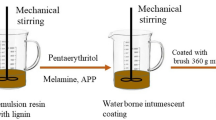Abstract
Acrylic emulsion based painted red lauan plywood (Parashorea spp.) is most commonly used for indoor furnishings. This study investigated the enhancement of the fire retardance of painted plywood by interaction among four major components of intumescent formulation: (1) acrylic emulsion resin as binder resin (BR), (2) pentaerythritol as carbonizing substance (CS), (3) melamine as foam producing substance (FPS) and (4) ammonium polyphosphate as dehydrating agent (DA). Effects of changing BR/CS ratios (designated as FRA series) and FPS/DA ratios (designated as FRM series) on flame-retardance of painted plywood were investigated using a cone calorimeter. The intumescent formulation significantly enhanced fire retardancy of painted plywood by exhibiting lower peak release rates and longer times to reach peak release rates, compared with uncoated plywood (UP) panel and plywood panel solely coated with acrylic emulsion resin. Lower BR content in the FRA series and lower FPS content in the FRM series were shown to enhance flame retardancy of painted plywood. The positive correlation between total heat release values under increasing combustion duration and incremental changes of BR and FPS contents in two series further verified the above findings. Consistent with the observed flame retardancy enhancement of painted plywood, lower heats of combustion and weight losses for paints in the FRM series were also identified by oxygen bomb calorimeter measurements and thermogravimetrical analysis. Infrared analysis of the chars indicated the formation of phosphate ester linkages with the lowest BR content in the FRA series and the lowest FPS content in the FRM series showing superior enhancements of flame retardancy for painted red lauan plywood.





Similar content being viewed by others
References
ASTM E1354-99 (1999) Standard test method for heat and visible smoke release rates for materials and products using an oxygen consumption calorimeter. American Society for Testing and Materials, West Conshohoken
ASTM E2382-88 (1988) Test method for heat of combustion of hydrocarbon fuels by bomb calorimeter (high-precision method). American Society for Testing and Materials, West Conshohoken
Baljinder KK, Horrocks AR (1996) Complex char formation in flame-retarded fire-intumescent combinations-II thermal analytical studies. Polym Degrad Stab 54:289–303
Bourbigot S, Le Bras M, Delobel R, Amourex JP (1996) Synergistic effect of zeolite in an intumescent process: study of the carbonaceous structures using solid-state NMR. J Chem Soc Faraday Trans 92:149–158
Bourbigot S, Le Bras M, Duquesne S, Rochery M (2004) Recent advances for intumescent polymers. Macromol Mater Eng 289:499–511
Camino G, Costa L, Martinasso G (1989) Intumescent fire-retardant seriess. Polym Degrad Stab 23(4):359–376
Chuang HB, Wang SY (2002) Effects of retention and distribution of fire retardant chemical on performance of fire retardant treated China fir (Cunninghamia lanceolata) wood. Holzforschung 56:209–214
Chinese National Standard CNS 6532 (1993) Method of test for the fire-resistibility of internal decorative material of building. National Standard Bureau, Taipei
Demir H, Arkis E, Balköse D, Ülkü S (2005) Synergistic effect of natural zeolites on flame retardant additives. Polym Degrad Stab 89:478–483
Drevelle C, Duquesne S, Le Bras M, Lefebvre J, Delobel R, Castrovinci A, Magniez C, Vouters M (2004) Influence of ammonium polyphosphate on the mechanism of thermal degradation of an acrylic binder resin. J Appl Polym Sci 94:717–729
Gao M, Sun CY, Wang CX (2006) Thermal degradation of wood treated with flame retardants. J Therm Anal Calorim 85:765–769
Horrocks AR, Price D (2001) Fire retardant materials. Woodhead Publishing Limited, UK, pp 1–30
Lindsay CI, Hill SB, Hearn M, Manton G, Everall N, Bunn A, Heron J, Fletcher I (2000) Mechanisms of action of phosphorus based flame retardants in acrylic polymers. Polym Intl 49:1183–1192
Ma ZC, Makelainen P (2000) Parametric temperature-time curves of medium compartment fires for structural design. Fire Saf J 34:361–375
Mitchell S (1993) Fire performance of wood: Test methods and fire retardant treatments. In: Proceedings of the 4th annual BCC conference on flame retardancy, 18–20 May, Stamford, CT. Business Communications Co., Norwalk, CT
Sain M, Park SH, Suhara F, Law S (2004) Flame retardant and mechanical properties of natural fibre-PP composites containing magnesium hydroxide. Polym Degrad Stab 83:363–367
SAS Institute Inc (1994) Statistical analysis software for microcomputer. SAS Institute Inc., Cary
Walters RN, Hackett SN, Lyon RE (2000) Heats of combustion of high temperature polymers. Fire Mater 24:245–252
Wladyka-Przbylak M, Kozlowski R (1999) The thermal characteristics of different intumescent coatings. Fire Mater 23:33–43
Zhu S, Shi W (2003) Thermal degradation of a new flame retardant phosphate methacrylate polymer. Polym Degrad Stab 80:217–222
Acknowledgments
Financial support (NSC95-2622-B-002-003-CC3) from the National Science Council, Taiwan is acknowledged.
Author information
Authors and Affiliations
Corresponding author
Rights and permissions
About this article
Cite this article
Chuang, CS., Tsai, KC., Wang, MK. et al. Effects of intumescent formulation for acrylic-based coating on flame-retardancy of painted red lauan (Parashorea spp.) thin plywood. Wood Sci Technol 42, 593–607 (2008). https://doi.org/10.1007/s00226-008-0197-2
Received:
Published:
Issue Date:
DOI: https://doi.org/10.1007/s00226-008-0197-2




